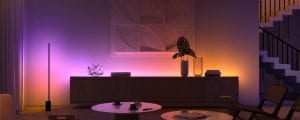Adding strip lights under your kitchen cabinets gives you focused, bright light for cooking, food preparation, and washing dishes. LED strip lights are a popular choice for kitchen cabinets, as they provide light directly over the space you’re working in.
Before you install your under-cabinet lighting, think about the type of countertop you have — the light will be shining directly onto it, after all. If you have a light-colored or glossy countertop, your strip light will not need to be as bright — the counter will bounce and reflect light upwards. However, if your countertop is a darker color or matte, it will absorb light — so the brightness of your strip light will need to be stronger.
Philips Hue lightstrips offer the most flexibility for kitchen under-cabinet lighting. With wireless smart light, you can dim and brighten your lightstrips for different times of day or cast your kitchen in colorful light to set the scene for a romantic dinner or party.


